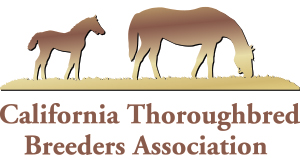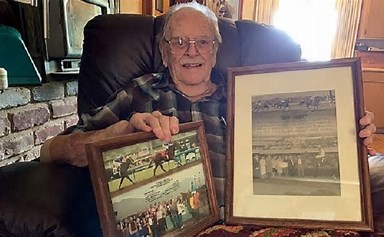From Bloodhorse.com
Most people would say William H. Nichols was a likeable guy, a nice guy even. But history tells another story: He is the one who famously made Charles Howard cry.
“My friends teased me about that for quite a while,” he recalled.
Nichols, who went on to success as a stakes-winning breeder in the Golden State and member of the Board of Directors of the California Thoroughbred Breeders Association, died Dec. 29 at his Mares’ Nest Farm near Wilton, Calif. He was 95.
The famed crying incident happened back in the spring of 1944 at Howard’s Buick dealership on Van Ness Avenue in San Francisco. Nichols had been invited by Howard to meet after the audacious teenager sent the “richest man west of the Mississippi” a letter asking for a job.
While in Howard’s office, Nichols noticed a painting on the wall of Frankie, Howard’s late son who died tragically as a young boy. Nichols asked Howard if the painting was of him, bringing tears to Howard’s eyes as chronicled in Laura Hillenbrand’s 2001 runaway best seller Seabiscuit: An American Legend.
“That time at Ridgewood really shaped my life,” Nichols said. “I learned the tools of the trade and became part of the Seabiscuit story.”
Seabiscuit also changed Nichols’ life in another, very personal way. His wife of 72 years, Lillian, wouldn’t give him the time of day until he asked her on a date to visit Ridgewood Ranch.
During his time at the ranch, he saw Seabiscuit’s near daily performance of his ritual greeting of visitors.
“Typically, he was lying down under his favorite oak tree,” Nichols recalled. “When his admirers filled the viewing stand, he would rise and walk over to greet them and then return to his tree.”
Amazingly, the 19-year-old Nichols was put in charge of caring for seven of Howard’s broodmares and their second-crop Seabiscuit foals. This group included the great race mare Illeanna, a Nichols’ favorite. He was also assigned the care of Vero, one of Howard’s stallions.
Decades later, Nichols became an important, first-hand source for Hillenbrand when she was researching her book. His recollections were invaluable given that his contemporaries from those days at Ridgewood would pass before him. At the prodding of a friend, Nichols answered Hillenbrand’s ad in the Thoroughbred Times, seeking to make contact with anyone who had a personal connection with Seabiscuit, Howard, trainer “Silent” Tom Smith, or jockeys Red Pollard and George Woolf.
Hillenbrand encouraged Nichols to write his 2007 book, which picks up where hers left off, entitled Seabiscuit: the Rest of the Story. Jack Shinar, then of the BloodHorse, for whom Nichols had been an expert source on Seabiscuit, wrote the book’s forward.
A few years after working at Ridgewood, Nichols married Lill, and the couple went on to other endeavors. They ultimately founded Mares’ Nest, now the oldest racehorse nursery in Northern California. Still in operation today, Nichols would look out his window at what is likely the last Mares’ Nest baby, a 2-year-old gelding by the late stallion Einstein out of the Cee’s Tizzy mare She’s a Tizzy.
This newly named youngster, Tiz a Genius, is milestone on his own, being the last foal by Einstein before his retirement to Old Friends in Georgetown, Ky.
Over his long career as a California Thoroughbred breeder, Nichols served on the board of the California Thoroughbred Breeders Association, and was honored with its 2014 President’s Award for his long service to the organization, as well as spearheading annual Northern California Yearling and Mixed Sales, and stallion tours.
From its small annual crops, Mares’ Nest Thoroughbred babies registered 24 stakes wins and 25 stakes placings over the years.
“We mostly bred four to five foals a year without spending much on mares and stud fees,” he recalled. Out of that program emerged two horses that any breeder would be proud to call their own.
Again, answering a classified ad, this time in a 1955 issue of the Thoroughbred of California, Bill and Lill met Walter J. Thomson, a South African businessman turned Thoroughbred breeder and owner. He was looking for someone to lease his stallion and 10 mares. One of those mares was Sea Flora, a daughter by Seabiscuit out of guess who: the mare Illeanna. Nichols saw that as a sign that it was meant to be. Furthermore, turns out Thomson’s first winner was sired by Grog, the horse “Silent” Tom Smith often trotted out to the press masquerading as Seabiscuit.
Thomson, who owned Rancho Felicia in Santa Ynez, Calif., became a mentor and best friend to the couple, and together they bred Sea Orbit, a son of Orbit II—Sea Flora, by Seabiscuit. It was Nichols who helped Sea Flora foal the healthy bay colt in 1956. Lill hand-fed the baby “until his dam decided he was OK,” Nichols said.
Sea Orbit had 67 starts, with a record of 22-13-7 and career earnings of $291,275. He won from the age of 3 through 7, including victories in two major events at the time: the Bay Meadows and Bing Crosby handicaps. At 4, he set a track record at Bay Meadows in the William P. Kyne Memorial Handicap of 1:47 flat for nine furlongs on the dirt. His stud career and life were cut short in 1969 by a deadly reaction to a vaccine.
It was 47 years later that another foal dropped at Mares’ Nest that made Nichols take notice. This was the filly Bai and Bai, a chestnut daughter of Falstaff out of the Fappiano mare Bai Shun. Bai and Bai started 29 times, for the late Robert and Beverly Lewis, compiling a record of 11-7-4 and earning $724,983. She raced from ages 2 through 6, and at age 4, became graded stakes placed in both the Clement L. Hirsch Handicap (G2) and the La Canada Stakes (G2). She would be named 2006 Champion Cal-Bred 3-Year-Old Filly. After retirement, she spent five years in the broodmare band at Calumet Farm, producing four foals. Her dam lived out her life at Mares’ Nest, passing in 2014 at the age of 29.
After Hillenbrand’s book was published, Nichols’ life took on another dimension as keeper of the Seabiscuit memory. He was pressed into service as a member of the Seabiscuit Heritage Foundation Board of Directors, sought-after as a speaker by community groups, and hosted Seabiscuit Tours at Ridgewood Ranch.
The book and the subsequent motion picture led to interviews with general and industry publications, more speaking engagements, and questions from everyone from students working on term papers to ladies of the Red Hat Society.
That’s when Nichols decided, at the age of 82, to answer all the questions in a book of his own, painstakingly researching what happened to Seabiscuit’s connections after his death. He traced the life of Charles Howard, trying to replace his beloved Seabiscuit with additions to his racing and breeding operations. Noor, a son of Nasrullah, helped with that quest and Howard, who died in 1950, lived long enough to see his first two of four showdowns with Citation, after which his widow, Marcela saw the last two before her death at age 84.
Nichols’ book followed Tom Smith and Red Pollard through their deaths and Smith’s subsequent induction into the National Thoroughbred Racing Hall of Fame, and Seabiscuit himself, whose blood lines have all but petered out. One of his few remaining, well-documented descendants is Windy Land, a great-great-great grandson living out his life at Old Friends Thoroughbred Retirement.
One of Nichols’ finest contributions to the Seabiscuit legacy is his myth-busting research. For example, Seabiscuit was not a violent, ill-tempered horse as sometimes depicted. Nichols described him as confident, professional, and quiet, enough so that the elderly Howard felt comfortable riding him around the expansive Ridgewood Ranch during the last years of their lives.
Since his book’s publication in 2007, Nichols was prodded by his publisher to write an update; he also thought about writing a piece on great mares. However, complete retirement finally called and he was content to let his legacy speak for itself, and to watch Tiz a Genius grow.


